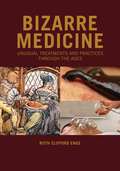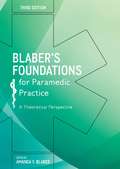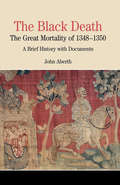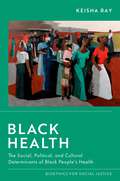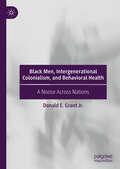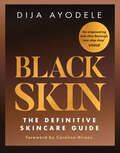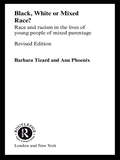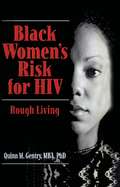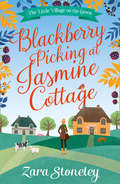- Table View
- List View
Bizarre Medicine: Unusual Treatments and Practices through the Ages
by Ruth Clifford EngsThis encyclopedia explores historical and contemporary fringe remedies seen as strange, ridiculous, or even gruesome by modern Western medicine but which nevertheless played an important role in the history of medicine.From placing leeches on the neck to treat a cough to using crocodile dung to prevent pregnancy, a number of medical treatments that now seem unusual were once commonplace. While a few of these remedies may have been effective, most were either useless or actually counterproductive to good health. Even today, there are alternative and fringe treatments considered bizarre by mainstream medicine yet used by hundreds of thousands of people.Bizarre Medicine: Unusual Treatments and Practices through the Ages offers a fascinating look into the history of medicine. Entries are organized by disease or medical condition and explore the folk and traditional "cures" used to treat them. Explanations are provided for why some treatments may have worked and why others may have done more harm than good. In addition, entries provide a clear description of the causes, symptoms, and current treatment options for each condition based on current scientific understanding. Each entry also discusses the condition's enduring impact on society and the arts.
Blaber's Foundations for Paramedic Practice: A theoretical perspective (UK Higher Education OUP Humanities & Social Sciences Health & Social Welfare)
by Amanda BlaberThis bestselling undergraduate level book is an ideal resource for student paramedics looking for an excellent introduction to the main theoretical subjects studied in paramedic courses, and links practice issues to the all-important theory base.The chapters bring to life a wide variety of academic subjects, making complex subjects easily readable and encouraging reflection on how theory fits with practice. This 3rd edition has been expanded throughout and includes five new chapters on research and evidence-based practice, human factors affecting paramedic practice, developing resilience, caring for people with dementia, and public health perspectives. This new edition also covers:• Ethics and law for the paramedic• Reflective practice and communication• Professional issues, including clinical audit and governance and anti-discriminatory practice• Psychological perspectives on health and ill health• Social factors• Care of vulnerable adults and end of life care• Safeguarding children• Managing change, decision making and leadership theoryWritten by a team of experienced paramedics, specialist health care professionals and doctors from across the UK, the book includes numerous links to practice, a wide selection of case studies and examples which encourage you to ‘stop and think’ and reflect upon your practice experience.Blaber’s Foundations for Paramedic Practice: A theoretical perspective, 3rd Edition is a core text for student paramedics and a valuable resource for students of all allied health professions."This book should be considered essential reading material for student paramedics endeavouring to understand the vital core concepts that underpin paramedic science. This clear, concise and user-friendly text is also invaluable for newly qualified paramedics, experienced paramedics looking to continue their own professional development and those acting as Practice Educators".Sarah Christopher, PGC LTHE, BSc (Hons), MA Ed, FHEA, MC Para, Programme Lead for Paramedic Science, The University of Lincoln, UK
Black Bag Moon: Doctors' Tales from Dusk to Dawn
by Susan Woldenberg ButlerBlack Bag Moon: Doctors' Tales from Dusk to Dawn is filled with inspiring, educational, entertaining and often quirky tales. Based on a series of interviews conducted with general practitioners across the globe, the book creatively presents myriad aspects of clinical practice. Each fictionalised story illustrates various themes in the human condition, whilst simultaneously highlighting the struggles and achievements of both patients and doctors. This insightful collection offers stimulating reading for all healthcare professionals and general readers alike, who will appreciate the honest, often moving scenes which effortlessly unfold in each chapter.
Black Bag Moon: Doctors' Tales from Dusk to Dawn
by Susan Woldenberg ButlerBlack Bag Moon: Doctors' Tales from Dusk to Dawn is filled with inspiring, educational, entertaining and often quirky tales. Based on a series of interviews conducted with general practitioners across the globe, the book creatively presents myriad aspects of clinical practice. Each fictionalised story illustrates various themes in the human condition, whilst simultaneously highlighting the struggles and achievements of both patients and doctors. This insightful collection offers stimulating reading for all healthcare professionals and general readers alike, who will appreciate the honest, often moving scenes which effortlessly unfold in each chapter.
Black-body Radiative, Thermodynamic, and Chromatic Functions: Tables In Finite Spectral Ranges
by Anatoliy I. Fisenko Vladimir F. LembergThis book provides detailed calculated values for the thermal radiative and thermodynamic functions of black-body radiation in finite spectral ranges. The results are presented in tabular form. The areas of thermal power generation, infrared medical diagnostics, solar power and nuclear generation, and astrophysics are included. A range of the thermal radiative and thermodynamic functions are calculated by the authors in the finite frequency/wavenumber/wavelength intervals at different temperatures. This book also contains the tables of the chromaticity coordinates and RGB parameters calculated for different color spaces (Rec.709 (HDTV), sRGB, Adobe RGB). A number of the optimization problems is formulated and solved for various thermal black-body radiative and thermodynamic functions in a finite range of frequencies.
Black cumin (Food Bioactive Ingredients)
by Mohamed Fawzy RamadanRecent developments in the field of nutrition have led to increased interest in herbs and medicinal plants as phytochemical-rich sources for functional food, nutraceuticals, and drugs. As research sheds light on the therapeutic potential of various bioactive phytochemicals, the demand for plant extracts and oils has increased. Black cumin or black seeds (Nigella sativa) have particularly widespread nutritional and medicinal applications. In traditional medicine, black seeds are used to manage fatigue and chronic headache. Black seed oil is used as an antiseptic and analgesic remedy and for treatment of joint's pain and stiffness and can be mixed with sesame oil to treat dermatosis, abdominal disorders, cough, headache, fever, liver ailments, jaundice, sore eyes, and hemorrhoids. Thymoquinone, the main constituent in black seed volatile oil, has been shown to suppress carcinogenesis. Black cumin (Nigella sativa) seeds: Chemistry, Technology, Functionality, and Applications presents in detail the chemical composition, therapeutic properties, and functionality of high-value oils, phytochemicals, nutrients, and volatiles of the Nigella sativa seed. Organized by formulation (seeds, fixed oil, essential oil, and extracts), chapters break this seed down into its chemical constituents and explore their role in the development of pharmaceuticals, nutraceuticals, novel food, natural drugs, and feed. Following numerous reports on the health-promoting activities of Nigella sativa, this is the first comprehensive presentation of the functional, nutritional, and pharmacological traits of Nigella sativa seeds and seed oil constituents.
The Black Death: The Great Mortality of 1348-1350: A Brief History with Documents (The Bedford Series in History and Culture)
by NA NAA fascinating account of the phenomenon known as the Black Death, this volume offers a wealth of documentary material focused on the initial outbreak of the plague that ravaged the world in the 14th century. A comprehensive introduction that provides important background on the origins and spread of the plague is followed by nearly 50 documents organized into topical sections that focus on the origin and spread of the illness; the responses of medical practitioners; the societal and economic impact; religious responses; the flagellant movement and attacks on Jews provoked by the plague; and the artistic response. Each chapter has an introduction that summarizes the issues explored in the documents; headnotes to the documents provide additional background material. The book contains documents from many countries - including Muslim and Byzantine sources - to give students a variety of perspectives on this devastating illness and its consequences. The volume also includes illustrations, a chronology of the Black Death, and questions to consider.
The Black Flies of Subtropical and Tropical Asia: Taxonomy and Biology
by Hiroyuki TakaokaThis book uncovers the entire picture of the black fly (Diptera: Simuliidae) fauna in subtropical and tropical Asia (the Oriental Region). Increased discoveries of new species of black flies in the Oriental Region have disclosed a remarkable diversity in terms of phylogenetic lineages and morphological features, particularly adult genitalia and pupal gills. The black fly fauna in the Oriental Region is found to be completely different from those in other regions. The book has two aims, academic and practical. Introduction provides the general information on the biology and effects on human and animal health and welfare of black flies and introduces the unique characteristics of the black fly fauna in this region. Chapter 2 proposes a classification scheme for all 675 named and 44 unnamed species of Oriental black flies, which are placed 11 subgenera and 36 species-groups of the genus Simulium. In Chapter 3, synoptic accounts are given for their distribution, bionomics, and taxonomic comments of all the species. In Chapter 4, the faunas of black flies in 15 countries or areas [India, Nepal, Bhutan, Sri Lanka, Myanmar, Thailand, Peninsular Malaysia, Borneo, Sunda Archipelago (Sumatra, Java, Bali, Lombok, Sumbawa, Flores and Timor), East Indonesia (Sulawesi, Maluku Islands and Irian Jaya), Vietnam, Philippines, Taiwan, South China, Nansei Islands (Japan)], are overviewed, and species lists and identification keys for females, males, pupae and larvae, are constructed. Ninety-eight figures of 1,691 line-drawings highlight various unique morphological characteristics of most subgenera and species-groups. Chapters 2 and 3 are academically essential for medical or biological scientists and students to study black flies. Keys to identify species in 15 countries or areas in Chapter 4 are of practical use for health workers for the control of insects of medical and veterinary importance, as well as for ecologists for the study of aquatic invertebrates. Many novel morphological characteristics illustrated in the figures appeal to readers and show the importance of biodiversity of natural terrestrial ecosystems. Contents of this book resulted from the author’s taxonomic review of all 719 Oriental species of black flies, with reference to 486 publications.
Black Health: The Social, Political, and Cultural Determinants of Black People's Health (Bioethics for Social Justice)
by Keisha RayWhy do American Black people generally have worse health than American White people? To answer this question, Black Health dispels any notion that Black people have inferior bodies that are inherently susceptible to disease. This is simply false racial science used to justify White supremacy and Black inferiority. A genuine investigation into the status of Black people's health requires us to acknowledge that race has always been a powerful social category that gives access to the resources we need for health and wellbeing to some people, while withholding them from other people. Systemic racism, oppression, and White supremacy in American institutions have largely been the perpetrators of differing social power and access to resources for Black people. It is these systemic inequities that create the social conditions needed for poor health outcomes for Black people to persist. An examination of social inequities reveals that is no accident that Black people have poorer health than White people. Black Health provides a succinct discussion of Black people's health, including the social, political, and at times cultural determinants of their health. Using real stories from Black people, Ray examines the ways in which Black people's multiple identities--social, cultural, and political--intersect with American institutions--such as housing, education, environmentalism, and health care--to facilitate their poor outcomes in pregnancy and birth, pain management, sleep, and cardiovascular disease.
Black Health: The Social, Political, and Cultural Determinants of Black People's Health (Bioethics for Social Justice)
by Keisha RayWhy do American Black people generally have worse health than American White people? To answer this question, Black Health dispels any notion that Black people have inferior bodies that are inherently susceptible to disease. This is simply false racial science used to justify White supremacy and Black inferiority. A genuine investigation into the status of Black people's health requires us to acknowledge that race has always been a powerful social category that gives access to the resources we need for health and wellbeing to some people, while withholding them from other people. Systemic racism, oppression, and White supremacy in American institutions have largely been the perpetrators of differing social power and access to resources for Black people. It is these systemic inequities that create the social conditions needed for poor health outcomes for Black people to persist. An examination of social inequities reveals that is no accident that Black people have poorer health than White people. Black Health provides a succinct discussion of Black people's health, including the social, political, and at times cultural determinants of their health. Using real stories from Black people, Ray examines the ways in which Black people's multiple identities--social, cultural, and political--intersect with American institutions--such as housing, education, environmentalism, and health care--to facilitate their poor outcomes in pregnancy and birth, pain management, sleep, and cardiovascular disease.
Black Health in the South
by Steven S. Coughlin Lovoria B. Williams Tabia Henry AkintobiA collection of important essays on the health and well-being of African Americans in the southern United States.For African Americans in the southern United States, the social determinants of health are influenced by a unique history that encompasses hundreds of years of slavery, injustices during the Jim Crow era, the Great Migration, the civil rights era, and contemporary experiences like the Black Lives Matter movement. In Black Health in the South, editors Steven S. Coughlin, Lovoria B. Williams, and Tabia Henry Akintobi bring together essays on this important subject from top public health experts.Black activists, physicians, and communities continue to battle inequities and structural problems that include poverty, inadequate access to health care, incarceration, a lack of transportation, and food insecurity. As the result of redlining and other historical and contemporary injustices, African Americans are less likely to own a home or to have equity, which places them in danger of financial ruin if they experience an illness such as a heart attack, stroke, or cancer, for which they are often at greater risk due to many social and environmental factors. At the same time, African American communities display many strengths and are often very resilient against these structural inequities. The use of community coalitions is a valuable approach for addressing health disparities in African American communities, and improving the cultural competence of health care providers further reduces the effects of health disparities.With essays spanning topics from culturally appropriate health care to faith-based interventions and the role of research networks in addressing disparities, this collection is pivotal for understanding the health of African Americans in the South. Public health scholars have examined racial disparities in health in the United States broadly and in specific cities, but this is the first edited collection to focus on African Americans in the South both as a whole and as a distinct population.
Black Health in the South
by Steven S. Coughlin, Lovoria B. Williams and Tabia Henry AkintobiA collection of important essays on the health and well-being of African Americans in the southern United States.For African Americans in the southern United States, the social determinants of health are influenced by a unique history that encompasses hundreds of years of slavery, injustices during the Jim Crow era, the Great Migration, the civil rights era, and contemporary experiences like the Black Lives Matter movement. In Black Health in the South, editors Steven S. Coughlin, Lovoria B. Williams, and Tabia Henry Akintobi bring together essays on this important subject from top public health experts.Black activists, physicians, and communities continue to battle inequities and structural problems that include poverty, inadequate access to health care, incarceration, a lack of transportation, and food insecurity. As the result of redlining and other historical and contemporary injustices, African Americans are less likely to own a home or to have equity, which places them in danger of financial ruin if they experience an illness such as a heart attack, stroke, or cancer, for which they are often at greater risk due to many social and environmental factors. At the same time, African American communities display many strengths and are often very resilient against these structural inequities. The use of community coalitions is a valuable approach for addressing health disparities in African American communities, and improving the cultural competence of health care providers further reduces the effects of health disparities.With essays spanning topics from culturally appropriate health care to faith-based interventions and the role of research networks in addressing disparities, this collection is pivotal for understanding the health of African Americans in the South. Public health scholars have examined racial disparities in health in the United States broadly and in specific cities, but this is the first edited collection to focus on African Americans in the South both as a whole and as a distinct population.
Black Lung: Anatomy of a Public Health Disaster
by Alan DericksonIn the definitive history of a twentieth-century public health disaster, Alan Derickson recounts how for decades after methods of prevention were known hundreds of thousands of American miners suffered and died from black lung, a respiratory illness caused by the inhalation of coal mine dust. The combined failure of government, medicine, and industry to halt the spread of this disease—and even to acknowledge its existence—resulted in a national tragedy, the effects of which are still being felt.The book begins in the late nineteenth century, when the disorders brought on by exposure to coal mine dust was first identified as components of a debilitating and distinctive illness. For several decades thereafter, coal miners’ dust disease was accepted, in both lay and professional circles, as a major industrial disease. Derickson describes how after the turn of the century medical professionals and industry representatives worked to discredit and supplant knowledge about black lung, with such success that this disease ceased to be recognized. Many authorities maintained that breathing coal mine dust was actually beneficial to health.Derickson shows that activists ultimately forced society to overcome its complacency about this deadly and preventable disease. He chronicles the growth of an unprecedented movement—from the turn-of-the-century miners’ union, to the social medicine activists in the mid-twentieth century, and the black lung insurgents of the late sixties—which eventually won landmark protections and compensation with the enactment of the Federal Coal Mine Health and Safety Act in 1969.An extraordinary work of scholarship, Black Lung exposes the enormous human cost of producing the energy source responsible for making the United States the world’s preeminent industrial nation. The book also provides a stark warning about the risks of ignoring or denying the existence of an occupational disease. Americans today are paying dearly for the decades when black lung was not recognized: compensation to disabled miners and their families has cost more than thirty billion dollars thus far. More important, society’s denial of the dangers of coal mine dust shortened and impoverished the lives of miners, who today are too often breathless and displaced, destroyed by their work.
Black Men, Intergenerational Colonialism, and Behavioral Health: A Noose Across Nations
by Donald E. Grant Jr.This book provides an in-depth historical exploration of the risk and protective factors that generate disproportionality in the psychological wellness, somatic health, and general safety of Black men in four industrialized Euronormative nations. It provides a detailed analysis of how nationalism, globalism, colonialism, and imperialism have facilitated practices, philosophies, and policies to support the development and maintenance of inter-generational systems of oppression for Black men and boys. The text juxtaposes empirically-supported constructs like historical trauma and epigenetics with current outcomes for Black men in the US, the UK, France and Canada. It details how contemporary institutions, practices, and policies (such as psychological testing, the school to prison pipeline, and over-incarceration) are reiterations of historic ones (such as convict leasing, debt peonage, and the Jim Crow laws). The text uses paleontological, archaeological, and anthropological research to cover over 200,000 years of history. It closes with strength-based paradigms aimed to dismantle oppressive structures, support the post-traumatic growth of Black men and boys, and enhance the systems and practitioners that serve them.
Black Skin: The Definitive Skincare Guide
by Dija AyodeleThe ultimate skincare guide for Black women
Black Skin: The Definitive Skincare Guide (PDF)
by Dija AyodeleDija Ayodele takes you through the lifetime of skin, sharing transformative essentials from how to work out your skin type to the dos and don'ts for your everyday routine. She explains the best ingredients for your skin and your budget, and the issues that Black women face: hyperpigmentation, general skin discolouration and increased dryness. Dija examines the concept of identity, looking at the way history has shaped how Black women express themselves in beauty and skincare, and debunks common myths and misconceptions: do darker skin tones need SPF? And is there any truth to the saying 'Black don't crack?' Intelligent, informed and indispensable, this is the guide that every Black woman has been waiting for.
The Black Stork: Eugenics and the Death of "Defective" Babies in American Medicine and Motion Pictures since 1915
by Martin S. PernickIn the late 1910s Dr. Harry J. Haiselden, a prominent Chicago surgeon, electrified the nation by allowing the deaths of at least six infants he diagnosed as "defectives". He displayed the dying infants to journalists, wrote about them for the Hearst newspapers, and starred in a feature film about his crusade. Prominent Americans from Clarence Darrow to Helen Keller rallied to his support. Martin Pernick tells this captivating story--uncovering forgotten sources and long-lost motion pictures--in order to show how efforts to improve human heredity (eugenics) became linked with mercy killing, as well as with race, class, gender and ethnicity. It documents the impact of cultural values on science along with the way scientific claims of objectivity shape modern culture. While focused on early 20th century America, The Black Stork traces these issues from antiquity to the rise of Nazism, and to the "Baby Doe", "assisted suicide" and human genome initiative debates of today.
The Black Sun (Tom Kirk Ser. #2)
by James TwiningHigh adventure, mind–blowing suspense. Tom Kirk, the world’s greatest art thief, is back on another life–threatening mission. Now available in e-book format for the first time.
Black, White or Mixed Race?: Race and Racism in the Lives of Young People of Mixed Parentage
by Ann Phoenix Barbara TizardThe number of people in racially mixed relationships has grown steadily over the last thirty years, yet these people often feel stigmatised and unhappy about their identities. The first edition of Black, White or Mixed Race? was a ground-breaking study: this revised edition uses new literature to consider what is now known about racialised identities and changes in the official use of 'mixed' categories. All new developments are placed in a historical framework and in the context of up-to-date literature on mixed parentage in Britain and the USA. Based on research with young people from a range of social backgrounds the book examines their attitudes to black and white people; their identity; their cultural origins; their friendships; their experiences of racism. This was the first study to concentrate on adolescents of black and white parentage and it continues to provide unique insights into their identities. It is a valuable resource for all those concerned with social work and policy.
Black, White or Mixed Race?: Race and Racism in the Lives of Young People of Mixed Parentage
by Ann Phoenix Barbara TizardThe number of people in racially mixed relationships has grown steadily over the last thirty years, yet these people often feel stigmatised and unhappy about their identities. The first edition of Black, White or Mixed Race? was a ground-breaking study: this revised edition uses new literature to consider what is now known about racialised identities and changes in the official use of 'mixed' categories. All new developments are placed in a historical framework and in the context of up-to-date literature on mixed parentage in Britain and the USA. Based on research with young people from a range of social backgrounds the book examines their attitudes to black and white people; their identity; their cultural origins; their friendships; their experiences of racism. This was the first study to concentrate on adolescents of black and white parentage and it continues to provide unique insights into their identities. It is a valuable resource for all those concerned with social work and policy.
Black Women's Risk for HIV: Rough Living
by Quinn GentryAn inside look at the devastating impact of the HIV/AIDS epidemic on poor African American women Black Women&’s Risk for HIV: Rough Living is a valuable look into the structural and behavioral factors in high-risk environments-specifically inner-city neighborhoods like the "Rough" in Atlanta-that
Black Women's Risk for HIV: Rough Living
by Quinn GentryAn inside look at the devastating impact of the HIV/AIDS epidemic on poor African American women Black Women&’s Risk for HIV: Rough Living is a valuable look into the structural and behavioral factors in high-risk environments-specifically inner-city neighborhoods like the "Rough" in Atlanta-that
Blackberry Picking at Jasmine Cottage (The Little Village on the Green #2)
by Zara StoneleyReturn to the charming little village of Langtry Meadows and cosy up by the fire with this gorgeous romance that will warm your heart…
Blacks in Medicine: Clinical, Demographic, and Socioeconomic Correlations
by Richard Allen WilliamsThis socially conscious, culturally relevant book explores the little-known history and present climate of Black people in the medical field. It reveals the deficiencies in the American healthcare structure that have contributed to the mismanagement of healthcare in the Black population, and examines cross-currents that intersect with the major events in minority medical history. Illustrated across 10 expertly written chapters, this text features a longitudinal timeline with the presentation of evidence-based information drawn from historical, political, and clinical sources. The book begins with an analysis of diseases particularly prevalent in the Black community due to socioeconomic inequalities in available medical care. These diseases include sickle cell anemia, hypertension, heart failure, drug addiction, and HIV/AIDS. Bolstered by profiles of historically well-known Black physicians, stories of success in medical education, and the remarkable impact of Black medical organizations, subsequent chapters address the triumphs and tribulations of the Black medical professional in America. Concluding with an examination of the current health status of Black people in the United States, the book makes a case for future systemic improvements in healthcare delivery to minority communities. A unique, noteworthy reference, Blacks in Medicine: Clinical, Demographic, and Socioeconomic Correlations is written for a broad range of physicians and health providers, as well as professionals in the social sciences and public health.
